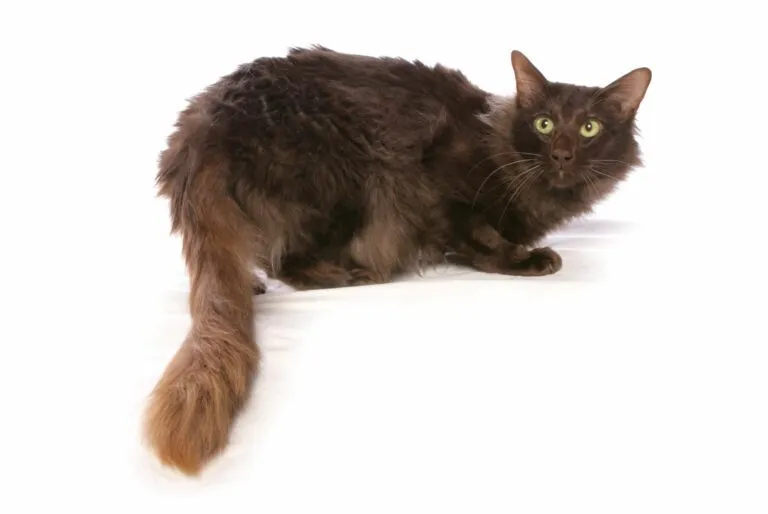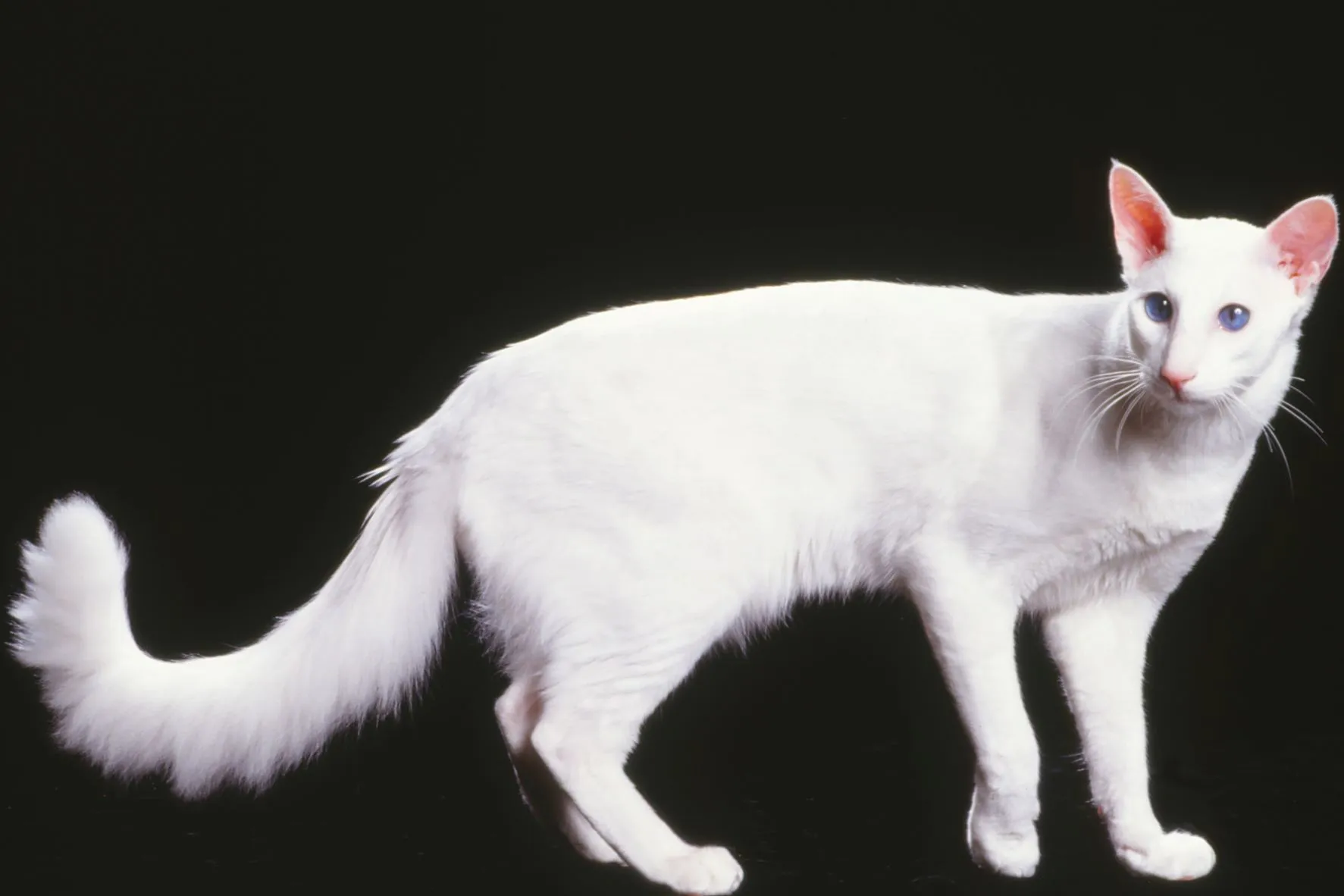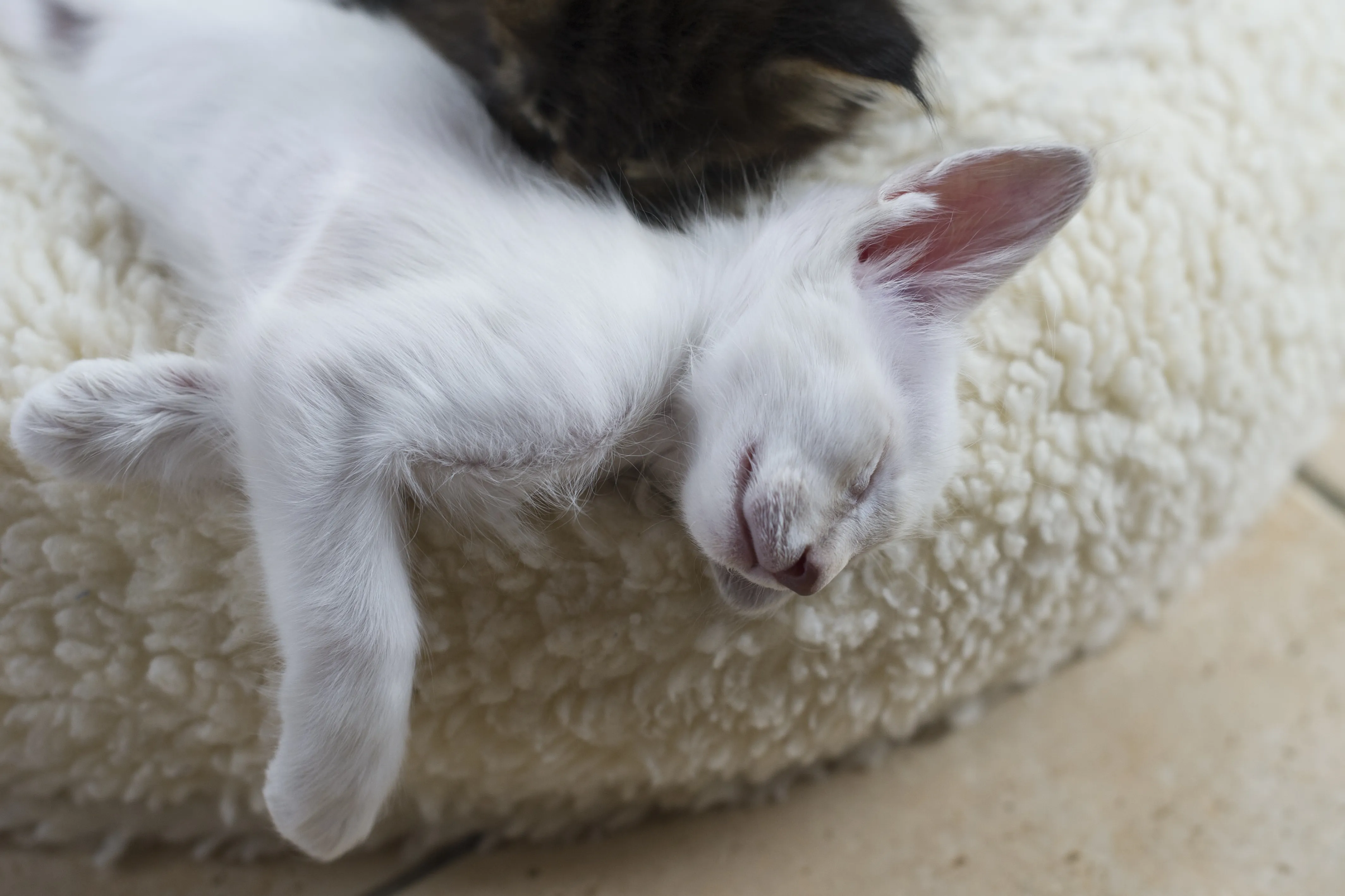Maine Coon
The Maine Coon has become one of the most popular cat breeds in the world. This is probably due to its majestic appearance, robust nature and great character.
16 Feb 2024 | The Javanese is a semi-longhaired cat and is also known as the Oriental Longhair (OLH) or Mandarin. A slender body, wedge-shaped head with large ears and silky fur are typical of this cat breed. Javanese cats are very cuddly and playful.

© Chris Brignell / stock.adobe.com
The Javanese is a semi-longhaired cat. Its bushy tail is a special feature.
The Javanese descends from the Siamese and is classed as a medium-sized cat. A female Javanese weighs between 3 and 4 kilograms and a male 4 to 5kg.
Like its relative, the Siamese, the Javanese is also slender and daintily built. Despite this, its body is muscular. Its rear legs are slightly longer than the front legs, so their back is raised slightly upwards.
With its triangular face, the Javanese also strongly resembles the Oriental Shorthair (OSH). There are two triangular ears on the wedge-shaped head. The nose is straight with no stop, so Javanese cats don’t have snub noses.
This breed usually has bright green or blue almond-shaped eyes. Some are also odd-eyed, with one green and one blue eye.
 © CallallooAlexis / stock.adobe.com
© CallallooAlexis / stock.adobe.com
Javanese cats have semi-long, silky fur with no undercoat. It lies close to the body. The tail is bushy and the fur is longer around the throat.
Javanese cats can come in many different fur colours. Here are some examples:
Some Javanese cats are also patterned – such as with tabby markings. Tabby cats are striped, brindled, spotted or ticked and have an M-shaped mark on their forehead.
Longhair cats have long, fluffy fur. For example, Persians, British Longhairs and German Longhairs are genuine longhair cats.
The longhair gene is inherited recessively, therefore does not always have a 100% effect on the appearance of the coat. This is the case with cat breeds like the Birman or Maine Coon with somewhat shorter fur. Javanese cats are also semi-longhair cats.
Javanese cats are lively, intelligent and meow a lot – there’s always something going on with a Javanese in the home. Moreover, these cats are very affectionate and want to be involved in the day-to-day life of their family.
Be sure to take time to play and snuggle with your cat. A Javanese will soon get offended if it feels it is getting a raw deal.
Clicker training is a good option to occupy your Javanese. Cats of this breed are considered very intelligent and are quick to learn new tricks.
You can find all kinds of cat toys in the zooplus online store to occupy your Javanese.
 © Heidi Bollich / stock.adobe.com
© Heidi Bollich / stock.adobe.com
Loneliness is the worst thing for a Javanese. Cats of this breed hate being alone. If you work away from home, you should definitely consider getting a second cat.
A fellow Javanese is most suitable, since they like cuddling one another. This could get too much for another cat.
Javanese cats are considered child-friendly, therefore make good family cats too. However, they are only suited to seniors to a limited extent, because they are very lively and have a big urge for exercise.
Cats of this breed can be kept as both outdoor and indoor cats. Like all indoor cats, they enjoy having a secured balcony or cat-proof garden.
Provided that you have enough time for extensive play and stroking sessions, keeping a Javanese isn’t particularly time-consuming. It’s sufficient to brush your semi-longhair cat’s fur once a week. Your cat will certainly enjoy this little wellness treatment.
Javanese cats are considered a robust breed, with no typical hereditary diseases known according to today’s level of knowledge. However, they don’t tolerate the cold very well since their fur has no undercoat.
Like with all other cats, you should take your Javanese to the vet once a year for a health check. Make sure that your cat is regularly vaccinated against the most significant feline diseases. Treatments against parasites may also be necessary.
The average life expectancy of a Javanese is around 15 years.
Has this cat breed won your heart? One way you can get a Javanese is from a breeder. Also search under the names Oriental Longhair, OLH or Mandarin.
However, you should ensure before purchasing a cat that the provider is a responsible breeder. Don’t just get them to show you the kittens, but their parents too. Also make sure that the cats are housed in a clean and species-appropriate way.
Kittens shouldn’t be younger than 12 weeks before you take them home. Before the handover, kittens should be vaccinated, microchipped and dewormed with complete paperwork. If this isn’t given, you’re better off looking elsewhere.
Cats are sometimes sold online too. Nevertheless, animal welfarists advise against such offers, because animals are often kept and ‘produced’ in questionable conditions.
A Javanese from a breeder costs around 1,000 pounds.
You might also strike lucky in your local animal shelter. It’s not all that uncommon for pedigree cats to end up in an animal shelter too. Animal homes generally give cats away for a low nominal fee.
Contrary to what the name suggests, Javanese cats have nothing to do with the Indonesian island Java. This is because the cat breed emerged when American breeders tried to create a semi-longhair Siamese.
The breeding efforts resulted in two oriental breeds with longer fur: The Balinese with its point markings and the Javanese with monotone or otherwise patterned fur.
In 1979, the American breeder organisation The Cat Fancier’s Association (CFA) recognised the Javanese as an independent breed. Furthermore, it is listed by other organisations as a variant of the Balinese.
If you choose a Javanese, you will gain a genuine family member: These attractive cats are affectionate, loveable housemates – but definitely need people with enough time for them.
| Breed | Javanese, also known as Colorpoint Longhair in some registries |
| Origin | United States |
| Description | Affectionate, people-oriented cat with a long, flowing coat |
| Similar breed | Siamese (but with a longer coat) |
| Weight (female) | 3-4 kg (6.6 – 8.8 lbs) |
| Weight (male) | 4-5 kg (8.8 – 11 lbs) |
| Lifespan | 15 years |
| Price | £1000 per kitten (price depends on pedigree and breeder) |
| Temperament | Intelligent, playful, talkative, lively, needs attention |
| Coat colors | Cream, chocolate, black, red, blue, tabby in various combinations |
| Eye color | Blue (can be blue or even heterochromatic in the white variation) |
| Grooming needs | Moderate |
| Gestation period | 60-65 days |
| Litter size | 3 or 4 kittens |
| Known health conditions | Not mentioned |
| Tendency to shed | Moderate |
| Good with children | Yes |
| Good with other cats | Yes, but adopting two Javanese together is recommended due to their social nature |
| Apartment living | Yes |
Here are some purchase proposals curated by the zooplus editorial team
The products featured have been carefully selected by our editorial staff and are available at the zooplus online pet shop. The selection does not constitute advertising for the mentioned brands.
The Maine Coon has become one of the most popular cat breeds in the world. This is probably due to its majestic appearance, robust nature and great character.
Large eyes and attentively upright ears instantly tell you a great deal about this charming breed of cat: Abyssinians are inquisitive and affectionate towards people.
With its long, dense fur, rounded ears, and intense stare, the Pallas Cat, or Manul, looks rather fluffy, yet somewhat dangerous. However, don't be fooled by its appearance—this is no petting zoo resident. The Manul is a wild animal and considered untameable.